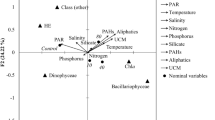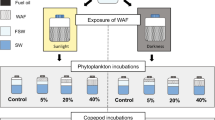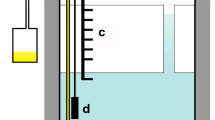Abstract
To evaluate the effects of crude oil water accommodated fraction (WAF) on marine phytoplankton community, natural phytoplankton collected seasonally from the Yueqing bay were exposed to eight groups of crude oil WAF for 15 days under laboratory conditions. Chlorophyll a and cell density were measured, and species of phytoplankton were identified every 24 h to reflect the change of phytoplankton community. The results showed that (1) High concentrations (≥2.28 mg l − 1) of oil pollution would greatly restrain phytoplankton growth (p < 0.001), decrease chlorophyll a content and cell density, whereas low concentrations (≤1.21 mg l − 1) did not restrain its growth but rather promoted the phytoplankton growth. (2) The biodiversity, evenness, and species number of phytoplankton were all significantly influenced by crude oil WAF in all seasons (p < 0.001). (3) The dominant species changes were different under different pollutant concentrations in different seasons. Different species had different tolerances to the oil pollution, thus leading to abnormal succession.
Similar content being viewed by others
References
Aksmann, A., & Tukaj, Z. (2004). The effect of anthracene and phenanthrene on the growth, photosynthesis, and SOD activity of the green alga Scenedesmus armatus depends on the PAR irradiance and CO2 level. Archives of Environmental Contamination and Toxicology, 47(2), 177–184.
Aksmann, A., & Tukaj, Z. (2008). Intact anthracene inhibits photosynthesis in algal cells: A fluorescence induction study on Chlamydomonas reinhardtii cw92 strain. Chemosphere, 74(1), 26–32.
Al-Hasan, R. H., Sorkhoh, N. A., Al-Bader, D., & Radwan, S. S. (1994). Utilization of hydrocarbons by cyanobacteria from microbial mats on oily coasts of the Gulf. Applied Microbiology and Biotechnology, 41(5), 615–619.
Anderson, J. W., Neff, J. M., Cox, B. A., Tatem, H. E., & Hightower, G. M. (1974). Characteristics of dispersion and water-soluble extracts of crude and refined oils and their toxicity to estuarine crustaceans and fish. Marine Biology, 27(1), 75–88.
Bejarano, A. C., Chandler, G. T., He, L., & Coull, B. C. (2006). Individual to population level effects of South Louisiana crude oil water accommodated hydrocarbon fraction (WAF) on a marine meiobenthic copepod. Journal of ExperimentalMarine Biology and Ecology, 332(1), 49–59.
Belzile, C., Demers, S., Ferreyra, G. A., Schloss, I., Nozais, C., Lacoste, K., et al. (2006). UV effects on marine planktonic food webs: A synthesis of results from mesocosm studies. Photochemistry and Photobiology, 82(4), 850–856.
Bopp, S. K., & Lettieri, T. (2007). Gene regulation in the marine diatom Thalassiosira pseudonana upon exposure to polycyclic aromatic hydrocarbons (PAHs). Gene, 396(2), 293–302.
Celik, M., & Er, I. D. (2006). Application requirements of catastrophe theory in maritime transportation industry. In International conference on maritime transport (3rd ed, pp. 879–887). 16–19 May, Barcelona, Spain.
Celik, M., & Topcu, Y. I. (2009). Use of an ANP to prioritize managerial responsibilities of maritime stakeholders in environmental incidents: An oil spill case. Transportation Research Part D: Transport and Environment, 14(7), 502–506.
Díez, I., Secilla, A., Santolaria, A., & Gorostiaga, J. M. (2009). Ecological monitoring of intertidal phytobenthic communities of the Basque Coast (N. Spain) following the Prestige oil spill. Environmental Monitoring and Assessment, 159(1–4), 555–575.
El-Dib, M. A., Abou-Waly, H. F., & El-Naby, A. H. (2001). Fuel oil effect on the population growth, species diversity and chlorophyll a content of freshwater microalgae. International Journal of Environmental Health Research, 11(2), 189–197.
Fiala, M., & Delille, D. (1999). Annual changes of microalgae biomass in Antarctic sea ice contaminated by crude oil and diesel fuel. Polar Biology, 21(6), 391–396.
Fleeger, J. W., Carman, K. R., & Nisbet, R. M. (2003). Indirect effects of contaminants in aquatic ecosystems. Science of the Total Environment, 317(1–3), 207–233.
Gao, Z. H., Yang, J. Q., & Wang, P. G. (2007). Theory, method, and case study of ecological lost assessment on the marine oil spill (pp. 291–358). Beijing: Ocean Press.
González, J. J., Viñas, L., Franco, M. A., Fumega, J., Soriano, J. A., Grueiro, G., et al. (2006). Spatial and temporal distribution of dissolved/dispersed aromatic hydrocarbons in seawater in the area affected by the Prestige oil spill. Marine Pollution Bulletin, 53(5–7), 250–259.
González, J., Figueiras, F. G., Aranguren-Gassis, M., Crespo, B. G., Fernández, E., Morán, X. A. G., et al. (2009). Effect of a simulated oil spill on natural assemblages of marine phytoplankton enclosed in microcosms. Estuarine, Coastal and Shelf Science, 83(3), 265–276.
Gordon, D. C., & Prouse, N. J. (1973). The effects of three oils on marine phytoplankton photosynthesis. Marine Biology, 22(4), 329–333.
Gulec, I., & Holdway, D. A. (1997). Toxicity of dispersant, oil and dispersed oil to two marine organisms. In International oil spill conference improving environmental protection progress, challenges, responsibilities. Fort Lauderdale, Florida.
Hjorth, M. (2008). Plankton stress responses from PAH exposure and nutrient enrichment. Marine Ecology Progress Series, 363, 121–130.
Hjorth, M., Vester, J., Henriksen, P., Forbes, V., & Dahlloef, I. (2007). Functional and structural responses of marine plankton food web to pyrene contamination. Marine Ecology Progress Series, 338, 21–31.
Ibrahim, M. B. M., & Gamila, H. A. (2004). Algal bioassay for evaluating the role of algae in bioremediation of crude oil: II. freshwater phytoplankton assemblages. Bulletin of Environmental Contamination and Toxicology, 73(6), 971–978.
Jewson, D. H. (1992). Size reduction, reproductive strategy and the life cycle of a centric diatom. Philosophical Transactions: Biological Science, 336(1277), 191–213.
Juhasz, A. L., & Naidu, R. (2000). Bioremediation of high molecular weight polycyclic aromatic hydrocarbons: A review of the microbial degradation of benzo[a]pyrene. International Biodeterioration and Biodegradation, 45(1–2), 57–88.
Koshikawa, H., Xu, K. Q., Liu, Z. L., Kohata, K., Kawachi, M., Maki, H., et al. (2007). Effects of the water-soluble fraction of diesel oil on bacterial and primary production and the trophic transfer to mesozooplankton through a microbial food web in Yangtze estuary, China. Estuarine, Coastal and Shelf Science, 71(1–2), 68–80.
Linden, O., Elmgren, R., & Boehm, P. (1979). The Tsesis oil spill: Its impact on the coastal ecosystem of the Baltic Sea. Ambio, 8(6), 244–253.
Liu, Y., Luan, T. G., Lu, N. N., & Lan, C. Y. (2006). Toxicity of fluoranthene and its biodegradation by Cyclotella caspia alga. Journal of Integrative Plant Biology, 48(2), 169–180.
Meng, W., Wang, L., & Zheng, B. (2007). Photoinduced toxicity single and binary mixtures of four polycyclic aromatic hydrocarbons to the marine diatom Skeletonema costatum. Acta Oceanologica Sinica, 26(6), 41–50.
Nayar, S., Goh, B. P. L., & Chou, L. M. (2005). Environmetal impacts of diesel fuel on bacteria and phytoplankton in a tropical estuary assessed using in situ mesocosms. Ecotoxicology, 14(3), 397–412.
Ohwada, K., Nishimura, M., Wada, M., Nomura, H., Shibata, A., Okamoto, K., et al. (2003). Study of the effect of water-soluble fractions of heavy-oil on coastal marine organisms using enclosed ecosystems, mesocosms. Marine Pollution Bulltin, 47(1–6), 78–84.
Paixão, J. F., Nascimento, I. A., Pereira, S. A., Leite, M. B. L., Carvalho, G. C., Silveira, J. S. C., et al. (2007). Estimating the gasoline components and formulations toxicity to microalgae (Tetraselmis chuii) and oyster (Crassostrea rhizophorae) embryos: An approach to minimize environmental pollution risk. Environmental Research, 103(3), 365–374.
Pielou, E. C. (1966). Species-diversity and pattern-diversity in the study of ecological succesion. Journal of Theorical Biology, 10, 370–383.
Pulich, W. M., Winters, K., & Van-Baalen, C. (1974). The effects of a No. 2 fuel oil and two crude oils on the growth and photosynthesis of microalgae. Marine Biology, 28(2), 87–94.
Salas, N., Ortiz, L., Gilcoto, M., Varela, M., Bayona, J. M., Groom, S., et al. (2006). Fingerprinting petroleum hydrocarbons in plankton and surface sediments during the spring and early summer blooms in the Galician coast (NW Spain) after the Prestige oil spill. Marine Environmental Research, 62(5), 388–413.
Sargian, P., Mas, S., Pelletier, É., & Demers, S. (2007). Multiple stressors on an Antarctic microplankton assemblage: Water soluble crude oil and enhanced UVBR level at Ushuaia (Argentina). Polar Biology, 30(7), 829–841.
Sargian, P., Mostajir, B., Chatila, K., Ferreyra, G. A., Pelletier, É., & Demers, S. (2005). Non-synergistic effects of water-soluble crude oil and enhanced ultraviolet-B radiation on a natural plankton assemblage. Marine Ecology Progress Series, 294, 63–77.
Semple, K. T., Cain, R. B., & Schmidt, S. (1999). Biodegradation of aromatic compounds by microalgae. Fems Microbiology Letters, 170(2), 291–300.
Shannon, C. E., & Weaver, W. (1949). The Mathematical Theory of Communication (pp. 117). Urbana, Illinois: University of Illinois Press.
Shi, X. Y., Wang, X. L., Han, X. R., Jiang, Y., Zhu, M. Y., Chen, S., et al. (2001). Relastionship between petroleum hydrocarbon and plankton in a mesocosm experiment. Acta Oceanologica Sinica, 20(2), 231–240.
Sibley, P. K., Harris, M. L., Bestari, K. T., Steele, T. A., Robinson, R. D., Gensemer, R. W., et al. (2001). Response of phytoplankton communities to liquid creosote in freshwater microcosms. Environmental Toxicology and Chemistry, 20(12), 2785–2793.
Sibley, P. K., Harris, M. L., Bestari, K. T., Steele, T. A., Robinson, R. D., Gensemer, R. W., et al. (2004). Response of zooplankton and phytoplankton communities to creosote-impregnated Douglas fir pilings in freshwater microcosms. Archives of Environmental Contamination and Toxicology, 47(1), 56–66.
Sikkema, J., Bont, J. A. M., & Poolman, B. (1995). Mechanisms of membrane toxicity of hydrocarbons. Microbiology Reviews, 59(2), 201–222.
Singh, A. K., & Kumar, H. D. (1991). Inhibitory effects of petroleum oil on photosynthetic electron transport system in the cyanobacterium Anabaena doliolum. Bulletin of Environmental Contamination and Toxicology, 47(6), 890–895.
Siron, R., Pelletier, E., & Roy, S. (1996). Effects of dispersed and adsorbed crude oil on microalgal and bacterial communities of cold seawater. Ecotoxicology, 5(4), 229–251.
Standardization Administration of China (2008a). GB/T 17378.4-2007 The specification for marine monitoring. Beijing: China Standards Press (in Chinese).
Standardization Administration of China (2008b). GB/T 12763.6-2007 The specification for oceanographic survey. Beijing: China Standards Press (in Chinese).
Stepaniyan, O. V. (2008). Effects of crude oil on major functional characteristics of macroalgae of the Barents Sea. Russian Journal of Marine Biology, 34(2), 131–134.
Varela, M., Bode, A., Lorenzo, J., Álvarez-Ossorio, M. T., Miranda, A., Patrocinio, T., et al. (2006). The effect of the “Prestige” oil spill on the plankton of the N–NW Spanish coast. Marine Pollution Bulletin, 53(5–7), 272–286.
Wang, L., & Zheng, B. (2008). Toxic effects of fluoranthene and copper on marine diatom Phaeodactylum tricornutum. Journal of Environmental Sciences-China, 20(11), 1363–1372.
Wang, L., Zheng, B., & Meng, W. (2008). Photo-induced toxicity of four polycyclic aromatic hydrocarbons, singly and in combination, to the marine diatom Phaeodactylum tricornutum. Ecotoxicology and Environmental Safety, 71(2), 465–472.
Werner, D. (1970). Productivity studies on diatom cultures. Helgoland Marine Research, 20(1–4), 97–103.
Wolfe, M. F., Olsen, H. E., Gasuad, K. A., Tjeerdema, R. S., & Sowby, M. L. (1999). Induction of heat shock protein (hsp) 60 in Isochrysis galbana exposed to sublethal preparations of dispersant and Prudhoe Bay crude oil. Marine Environmental Research, 47(5), 473–489.
Zhao, W. H., Wang, J. T., Li, J. T., Cui, X., Wu, Y. L., & Miao, H. (2006). Contrast of nutrient limiting phytoplankton growth in the Changjiang River Estuary and the adjacent areas between summer and winter. Acta Oceanologica Sinica, 28(3), 119–126.
Author information
Authors and Affiliations
Corresponding author
Electronic Supplementary Material
Below is the link to the electronic supplementary material.
Rights and permissions
About this article
Cite this article
Huang, YJ., Jiang, ZB., Zeng, JN. et al. The chronic effects of oil pollution on marine phytoplankton in a subtropical bay, China. Environ Monit Assess 176, 517–530 (2011). https://doi.org/10.1007/s10661-010-1601-6
Received:
Accepted:
Published:
Issue Date:
DOI: https://doi.org/10.1007/s10661-010-1601-6




